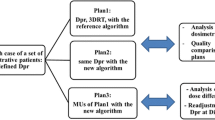Purpose:
To analyze different control-system limitations on the measured dose distributions in low-dose regions of simplified intensity fields with an electronic portal imaging device to ascertain the optimal settings for the control-system limitations in the planning system.
Material and Methods:
The authors created one field with an "optimal fluence" of intensity 1.0 (full dose) and one field with intensity 0.0 (no dose) in the central part of the field. The influence of different dose rates (DRs) and maximum leaf speeds (LS) on the calculated and measured dose and dose profiles were analyzed.
Results:
Good agreement between calculated and measured dose in the case of a field of intensity 1.0 was found. For the field with intensity 0.0, the measured dose was 20–60% lower than the dose calculated by the "actual fluence". The results were found dependent on the DR and LS.
Conclusion:
The overestimation in regions of optimal intensity 0.0 by the planning system cannot be resolved by the user. Taking the measured dose in the region of desired intensity 1.0 and other technical limitations (like beam hold interrupts or spikes in the cross and longitudinal profiles) into consideration, the application of an LS of 2.5 cm/s and a DR of 500 MU/min is recommended in order to minimize radiation dose applied to organs at risk, which are located in regions of low intensity, like, for example, the spinal cord.
Ziel:
Es wurden verschiedene Kontrollsystemlimitationen bezüglich ihrer Auswirkungen auf die gemessene Dosisverteilung in Niedrigdosisbereichen von vereinfachten intensitätsmodulierten Feldern mittels eines elektronischen Portal-Imaging-Systems untersucht, um darüber die optimalen Einstellungen des Planungssystems herauszufinden.
Material und Methodik:
Die Autoren kreierten ein Feld mit „optimaler Fluenz“ 1,0 (volle Dosis) und ein Feld mit Intensität 0,0 (keine Dosis) im zentralen Feldanteil. Die Auswirkungen verschiedener Dosisraten (DR) und maximaler Leafgeschwindigkeiten (LS) auf die errechnete und gemessene Dosis und Linienprofile der Felder wurden analysiert.
Ergebnisse:
Bei dem Feld mit Intensität 1,0 fand sich eine gute Übereinstimmung zwischen der errechneten und der gemessenen Dosis für alle Limitationen. Bei dem Feld mit Intensität 0,0 war die gemessene Dosis 20–60% niedriger als die errechnete Dosis der "aktuellen Fluenz". Die Ergebnisse waren abhängig von der gewählten DR und LS.
Schlussfolgerung:
Die Überschätzung der Dosis im Niedrigdosisbereich durch das Bestrahlungsplanungssytem kann momentan nicht durch den Benutzer behoben werden. Unter Berücksichtigung der in dem Feld mit Intensität 1,0 gemessenen Dosis und anderer technischer Limitationen (wie „beam hold interrupts“, Zacken in den Quer- und Längsprofilen) werden eine LS von 2,5 cm/s und eine DR von 500 MU/min befürwortet, um die applizierte Dosis in Niedrigdosisbereichen bei gleichzeitig optimaler technischer Applizierbarkeit zu reduzieren.
Similar content being viewed by others
References
Caglar HB, Allen AM. Intensity-modulated radiotherapy for head and neck cancer. Clin Adv Hematol Oncol 2007;5:425–431.
Greer PB, Vial P, Oliver L, et al. Experimental investigation of the response of an amorphous silicon EPID to intensity modulated radiotherapy beams. Med Phys 2007;34:4389–4398.
Guckenberger M, Flentje M. Intensity-modulated radiotherapy (IMRT) of localized prostate cancer. A review and future perspectives. Strahlenther Onkol 2007;183:57–62.
Jacob V, Kneschaurek P. A method for improved verification of entire IMRT plans by film dosimetry. Strahlenther Onkol 2009;185:34–40.
Jang SY, Liu HH, Mohan R. Underestimation of low-dose radiation in treatment planning of intensity-modulated radiotherapy. Int J Radiat Oncol Biol Phys 2008;71:1537–1546.
Jursinic PA, Nelms BE. A 2-D diode array and analysis software for verification of intensity modulated radiation therapy delivery. Med Phys 2003;30:870–879.
Lips IM, Dehnad H, van Gils CH, et al. High-dose intensity-modulated radiotherapy for prostate cancer using daily fiducial marker-based position verification: acute and late toxicity in 331 patients. Radiat Oncol 2008;3:15.
Litzenberg DW, Moran JM, Fraass BA. Incorporation of realistic delivery limitations into dynamic MLC treatment delivery. Med Phys 2002;29:810–820.
Low DA, Sohn JW, Klein EE, et al. Characterization of a commercial multileaf collimator used for intensity modulated radiation therapy. Med Phys 2001;28:752–756.
Muzik J, Soukup M, Alber M. Comparison of fixed-beam IMRT, helical tomotherapy, and IMPT for selected cases. Med Phys 2008;35:1580–1592.
Nicolini G, Fogliata A, Vanetti E, et al. What is an acceptably smoothed fluence? Dosimetric and delivery considerations for dynamic sliding window IMRT. Radiat Oncol 2007;2:42.
Olch AJ. Dosimetric performance of an enhanced dose range radiographic film for intensity-modulated radiation therapy quality assurance. Med Phys 2002;29:2159–2168.
Pai S, Das IJ, Dempsey JF, et al. TG-69: radiographic film for megavoltage beam dosimetry. Med Phys 2007;34:2228–2258.
Pasma KL, Dirkx ML, Kroonwijk M, et al. Dosimetric verification of intensity modulated beams produced with dynamic multileaf collimation using an electronic portal imaging device. Med Phys 1999;26:2373–2378.
Pinkawa M, Siluschek J, Gagel B, et al. Postoperative radiotherapy for prostate cancer. Evaluation of target motion and treatment techniques (intensity-modulated versus conformal radiotherapy). Strahlenther Onkol 2007;183:23–29.
Polat B, Guenther I, Wilbert J, et al. Intra-fractional uncertainties in image-guided intensity-modulated radiotherapy (IMRT) of prostate cancer. Strahlenther Onkol 2008;184:668–673.
Schmidhalter D, Fix MK, Niederer P, et al. Leaf transmission reduction using moving jaws for dynamic MLC IMRT. Med Phys 2007;34:3674–3687.
Stasi M, Giordanengo S, Cirio R, et al. IMRT verification with a 2D pixel ionization chamber: dosimetric and clinical results in head and neck cancer. Phys Med Biol 2005;50:4681–4694.
Studer G, Luetolf UM, Glanzmann C. Locoregional failure analysis in head-and-neck cancer patients treated with IMRT. Strahlenther Onkol 2007;183:417–423.
Van Esch A, Depuydt T, Huyskens DP. The use of an aSi-based EPID for routine absolute dosimetric pre-treatment verification of dynamic IMRT fields. Radiother Oncol 2003;71:223–234.
Warkentin B, Steciw S, Rathee S, et al. Dosimetric IMRT verification with a flat-panel EPID. Med Phys 2003;30:3143–3155.
Zhu XR, Jursinic PA, Grimm DF, et al. Evaluation of Kodak EDR2 film for dose verification of intensity modulated radiation therapy delivered by a static multileaf collimator. Med Phys 2002;29:1687–1692.
Author information
Authors and Affiliations
Corresponding author
Rights and permissions
About this article
Cite this article
Vorwerk, H., Wagner, D., Seitz, B. et al. Overestimation of Low-Dose Radiation in Intensity-Modulated Radiotherapy with Sliding-Window Technique. Strahlenther Onkol 185, 821–829 (2009). https://doi.org/10.1007/s00066-009-2028-2
Received:
Accepted:
Published:
Issue Date:
DOI: https://doi.org/10.1007/s00066-009-2028-2




